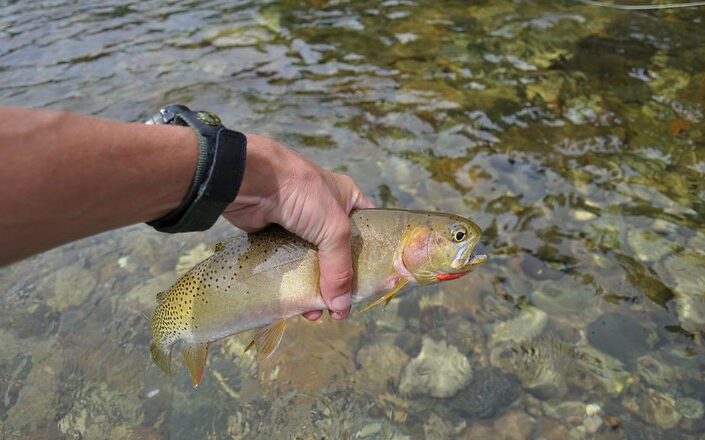Aspen leaves dance overhead. Gin-clear water tumbles and gurgles between mossy boulders. The silvery shape of a cutthroat trout rises gently to the surface, sipping a mayfly. You’ve arrived at Kelly Creek, and you’re about to experience some of the best backcountry fly fishing in Idaho.

Kelly Creek is sometimes called one of Idaho’s best-kept secrets, but like a lot of hidden gems, it isn’t really all that hidden. Lots of people know about Kelly Creek, but what helps keep it from being overrun is that it takes quite a bit of work to get to it. Remote access and spectacular scenery contribute just as much to the experience of fishing Kelly Creek as do its abundant and westslope cutthroats.
Fly Fishing Overview: Kelly Creek, Idaho
Just 26 miles in length, Kelly Creek is a tributary of the North Fork of the Clearwater River. From its headwaters near the Montana state line, it rolls and plunges through a steep and densely wooded canyon within Clearwater National Forest. It’s a high-gradient stream that is mostly quite narrow, and the fishing here is primarily pocket water.
Those pockets hold some of the most beautiful westslope cutthroat in Idaho, most of them measuring 12 to 14 inches. Plenty of cutts in the 20-inch class are caught here too; they often lurk a little deeper and outside of the faster currents where their smaller relatives feed.
Nymphing and dry fly fishing are both effective here. And while there are abundant hatches, it isn’t always necessary to match them with pinpoint accuracy. These trout are accustomed to making quick decisions in swift current, so being able to cast accurately and maintain a drag-free presentation is often more important than the finer details of fly selection.
Best Seasons for Fishing Kelly Creek
Kelly Creek is open to fishing year-round. It was one of the first Idaho streams to be designated strictly catch-and-release in the 1970s, and it remains so to this day (see complete regulations here).
Early-season fishing can be difficult, as wintry conditions often persist well into spring in the Bitterroot Mountains. Some good pre-runoff fishing is often available in May, but be prepared for the possibility of icy roads and snow. Runoff tends to make the river unfishable throughout most of June.
Summer is the best time to fish Kelly Creek. Runoff typically subsides by mid-July, and August is a beautiful month to be on the water. Stonefly hatches usually start while the water is still high and continue into August. Pale Morning Duns are the major mayfly hatch in summer, and they’re followed by Blue Winged Olives as the season starts to wane.
As great as summer can be, fall is often just as good. Arguably, the most important hatch of the year is the October Caddis, which often starts in early September and can extend almost to November.
Essential Gear & Top Flies for Kelly Creek
As a general rule, if you arrive at Kelly Creen and find an active hatch in progress, it’s wise to match it as closely as possible. Blue Winged Olive and Pale Morning Dun imitations should definitely be in your arsenal, as should October Caddis patterns if you’re fishing in fall. A selection of Elk Hair Caddis in brown, tan, olive and and black (size #12 – #16) will cover just about all of the year’s caddis hatches.
Otherwise, almost anything goes. Kelly Creek cutthroats seem to crave terrestrials in summer, making hopper, cricket, beetle and ant patterns effective. All kinds of big, bushy dries can tempt strikes too. Stimulators, Wulffs, Adams, Trudes and Humpies are all on the table, and many a westslope has fallen for a Fat Albert, Chubby Chernobyl or Madam X.
Pheasant Tail, Hare’s Ear and Olive Bead-head are top-producing nymphs. Dragging a weighted stonefly nymph right along the bottom is another go-to tactic. Nymphs can also be paired on a dropper beneath any of the aforementioned dry flies.
The ideal outfit for Kelly Creek is a 5 or 6-weight rod with a floating line. Although it’s a narrow stream, a rod with some decent length to it (9 feet or more) along with an 8-foot leader will help you keep as much line off the water as possible and control drag amid Kelly Creek’s strong currents and cross currents.
Kelly Creek is strewn with boulders that range from soccer ball-sized to automobile-sized. Those boulders create this stream’s exemplary pocket water, but they also make walking and wading a bit treacherous. Carry a wade staff and choose wading boots with good ankle support. Studded boots are also a good call here.
How to Reach Kelly Creek’s Remote Waters
Kelly Creek isn’t a short drive from anywhere, which is part of its charm. Starting in Pierce—the closest “city” with a population of around 500—it’s about a 2-hour drive on National Forest Route 250 to the confluence of Kelly Creek with the North Fork of the Clearwater.
At the confluence, you will find Kelly Forks Campground, the only developed campground on Kelly Creek (though there are several on the North Fork). From here, a gravel road continues up Kelly Creek and provides access to the creek’s lowermost 10 miles.
Road access ends at the Toboggan Ridge Road Bridge. The remainder of the creek is accessible only by following the hiking trail that begins at the nearby Kelly Creek #567 Trailhead. There’s some great fishing to be had on the lower section, but Kelly Creek’s roadless upper portion is the least pressured and offers some of the most exciting wild cutthroat action.

Great article!!